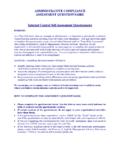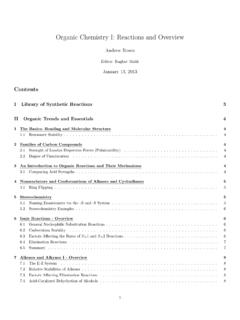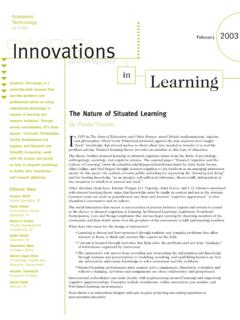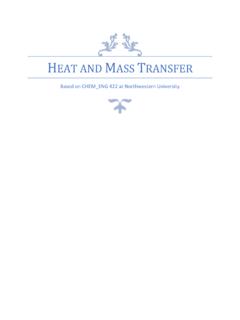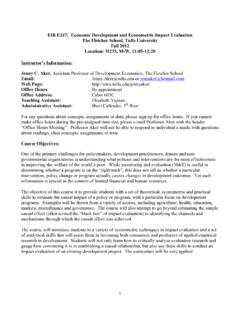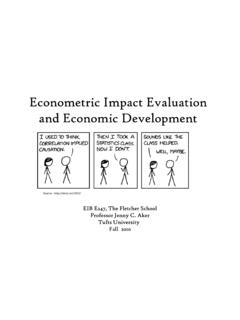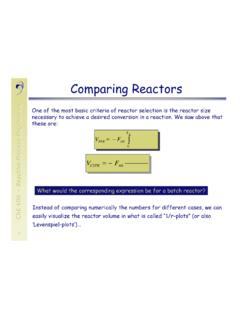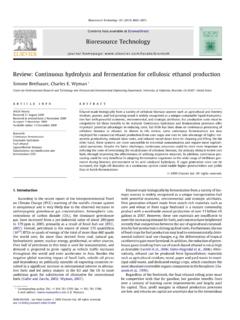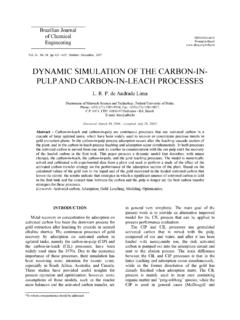Transcription of Reactor Design - Tufts University
1 Reactor DesignAndrew RosenMay 11, 2014 Contents1 Mole The Mole Balance .. Batch Reactor .. Continuous-Flow Reactors .. Continuous-Stirred Tank Reactor ( cstr ) .. Packed-Flow Reactor (Tubular) .. Packed-Bed Reactor (Tubular) .. 42 Conversion and Reactor Batch Reactor Design Equations .. Design Equations for Flow Reactors .. The Molar Flow Rate .. cstr Design Equation .. PFR Design Equation .. Sizing CSTRs and PFRs .. Reactors in Series .. Space Time and Space Velocity .. 73 Rate Laws and Rate Laws .. The Reaction Order and the Rate Law .. The Reaction Rate Constant .. Batch Systems .. Flow Systems .. 94 Isothermal Reactor Design Structure for Isothermal Reactors .. Scale-Up of Liquid-Phase Batch Reactor Data to the Design of a cstr .. Design of Continuous Stirred Tank Reactors .. A Single, First-Order cstr .
2 CSTRs in Series (First-Order) .. CSTRs in Parallel .. A Second-Order Reaction in a cstr .. Tubular Reactors .. Pressure Drop in Reactors .. Ergun Equation .. PBR .. PFR .. Unsteady-State Operation of Stirred Reactors .. Mole Balances on CSTRs, PFRs, PBRs, and Batch Reactors .. Liquid Phase .. Gas Phase .. 1715 Collection and Analysis of Rate Batch Reactor Data .. Differential Method .. Integral Method .. cstr Reaction Data .. PFR Reaction Data .. Method of Initial Rates .. Method of Half-Lives .. Differential Reactors .. 196 Multiple Definitions .. Parallel Reactions .. Maximizing the Desired Product of One Reactant .. Reactor Selection and Operating Conditions .. Maximizing the Desired Product in Series Reactions .. Algorithm for Solution of Complex Reactions .. 237 Reaction Mechanisms, Pathways, Bioreactions, and Active Intermediates and Nonelementary Rate Laws.
3 Enzymatic Reaction Fundamentals .. Inhibition of Enzyme Reactions .. Competitive Inhibition .. Uncompetitive Inhibition .. Noncompetitive Inhibition .. 258 Integral Table .. Rate Equations .. 2721 Mole The Mole Balance The variablerjshall represent the rate of formation of speciesjper unit volume Alternatively phrased,rjhas units of moles per unit volume per unit time ( concentration pertime) The rate of reaction is defined as rjsuch that it is a positive number for a reactant being consumed The rate equation is a function of the properties of the reacting materials and reaction conditions (notthe type of Reactor ) The general mole balance is given as the following for speciesA:FA0 FA+GA=dNAdtwhereFA0is the input molar flow rate,FAis the output molar flow rate,GAis the generation, andthe differential term is the accumulation (all units are moles/time) If the system variables are uniform throughout the system volume, thenGA=rAVwhereVis the system volume More generally, ifrAchanges with position in the system volume,FA0 FA+ rAdV= Batch Reactor A batch Reactor has no input or output when the reaction is occurring (FA0=FA= 0), sodNAdt= rAdVand if the reaction mixture is perfectly mixed so thatrAis independent of position,dNAdt=rAV The time,t, needed to reduce the number of moles fromNA0toNA1is given ast= NA0NA1dNA rAV SinceNA=CAVit can also be stated that (for a constant-volume batch Reactor )dCAdt= Continuous-Flow Continuous-Stirred Tank Reactor ( cstr ) CSTRs are operated at steady state (accumulation = 0) and are assumed to be perfectly mixed.
4 Thismakes the temperature, concentration, and reaction rate independent of position in the Reactor Since CSTRs are operated at steady state, there is no accumulation, and sincerAis independent ofposition,V=FA0 FA rA Ifvis the volumetric flow rate (volume/time) andCAis the concentration (moles/volume) of speciesA, then1FA=CAvsuch thatV=v0CA0 vCA Packed-Flow Reactor (Tubular) The tubular Reactor is operated at steady state. The concentration varies continuously down the tube,and, therefore, so does the reaction rate (except for zero order reactions) The phrase plug flow profile indicates that there is uniform velocity with no radial variation (butthere is axial variation) in reaction rate. A Reactor of this type is called a plug-flow Reactor (PFR) andis homogeneous as well as in steady-state For a PFR,dFAdV=rAand is not dependent on the shape of the Reactor (only on its total volume) The necessary volume,V, needed to reduce the entering molar flow rate,FA0, to some specific valueofFA1is given asV= FA0FA1dFA Packed-Bed Reactor (Tubular) For a heterogeneous reaction ( fluid-solid interactions), the mass of solid catalyst,W, is whatmatters instead of the system volume Therefore, the reaction rate has units of moles ofAper unit mass of catalyst per unit time For a heterogeneous Reactor ,GA=rAW The packed-bed Reactor (PBR)
5 , a type of catalytic Reactor operated at steady state, can have a reactionrate described bydFAdW=rA1 This is a general statement true for all reactors4 If the pressure drop and catalyst decay are neglected,W= FA0FA1dFA rAwhereWis the catalyst weight needed to reduce the entering molar flow rate ofA,FA0, to someFA12 Conversion and Reactor Batch Reactor Design Equations Conversion (of substance A) is defined asX=moles of A reactedmoles of A fed This can be rephrased mathematically asXi=Ni0 NiNi0= 1 CiVCA0V0 The number of moles of A in the Reactor after a conversionXhas been achieved isNA=NA0(1 X) By differentiating the above expression with respect totand plugging it into the expression for thebatch Reactor ,dNAdt=rAV, we getNA0dXdt= rAVandt=NA0 X0dX Design Equations for Flow The Molar Flow Rate The molar flow rate of substance A,FA, is given as the following for a flow reactorFA=FA0(1 X) Note that this isnotmultiplying flow rate by concentration, but, rather, by conversion For a gas, the concentration can be calculated using the ideal gas law (or other gas law if required) It can also be stated thatCA=CA0(1 X)
6 For batch reactors, conversion is a function of time whereas for flow reactors at steady state it is afunction of cstr Design Equation Using the expression for the volume of a given cstr derived earlier, we can eliminateFAby usingthe conversion ofFA0such that the Design equation isV=FA0X PFR Design Equation Similarly, the Design equation for a PFR isFA0dXdV= rA Therefore,V=FA0 X0dX rA For PBRs, simply Sizing CSTRs and PFRs For an isothermal Reactor , the rate is typically greatest at the start of the reaction when the concen-tration is greatest Recall that the Reactor volume for CSTRs and PFRs are functions of the inverse of the reactionrate For all irreversible reactions of greater than zero order, the volume of the Reactor approachesinfinity for a conversion of 1 (since the reaction rate approaches zero and the slope of the Levenspielplot approaches infinity) For reversible reactions, the maximum conversion is the equilibrium conversion where the reaction rateis zero (and thus the volume of the Reactor approaches infinity for a system in equilibrium as well) For an isothermal case, the cstr volume will typically be greater than the PFR volume for the sameconditions (except when zero order) This is because the cstr operates at the lowest reaction rate while the PFR starts at a high rateand decreases to the exit rate (which requires less volume since it is inversely proportional to therate) From aFA0 , the Reactor volumes can be found from areas as shown in the sample Levenspielplot Reactors in Series If we consider two CSTRs in series, we can state the following for the volume of one of the CSTRs(where thefsubscript stands for final and theisubscript stands for initial)V=FA0(1 rA)(Xf Xi)
7 If it is the first Reactor in the series, thenXi= 0 To achieve the same overall conversion, the total volume for two CSTRs in series is less than thatrequires for one cstr (this is not true for PFRs) The volume for a PFR where PFRs are in seriesV= XfXiFA0dX rA PFRs in series have the same total volume for the same conversion as one PFR, as shown below:Vtotal= X20FA0dX rA= X10FA0dX rA+ X2X1FA0dX rA A PFR can be modeled as infinitely many CSTRs in Space Time and Space Velocity Space time is defined as Vv0 The velocity is measured at the entrance condition For a PBR, =Wv0= b Space velocity is defined asSV v0V For a liquid-hourly space velocity (LHSV), the velocity is the liquid feed rate at 60 F or 75 F For a gas-hourly space velocity (GHSV), the velocity is measured at STP3 Rate Laws and Rate Laws The molecularity is the number of atoms, ions, or molecules colliding in a reaction step For a reaction aA+bB cC+dD, rAa= rBb=rCc= The Reaction Order and the Rate Law A reaction rate is described as (using the reaction defined earlier)
8 , rA=kAC AC Bwhere the order with respect to A is , the order with respect to B is , and the total order is + For a zero-order reaction, the units ofkare mol/L s For a first-order reaction, the units ofkare 1/s For a second-order reaction, the units ofkare L/mol s For an elementary reaction, the rate law order is identical to the stoichiometric coefficients For heterogeneous reactions, partial pressures are used instead of concentrations To convert between partial pressure and concentration, one can use the ideal gas law The reaction rate per unit volume is related to the rate of reaction per unit weight of catalyst via rA= ( r A) The equilibrium constant is defined (for the general reaction) asKC=kforwardkreverse=CcC,eqCdD,eqCaA,eq CbB,eq The units ofKCare(mol/L)d+c b a The net rate of formation of substanceAis the sum of the rates of formation from the forward reactionand reverse reaction for a system at equilibrium For instance, if we have the elementary, reversible reaction of2A B+C, we can state that rA,forward=kAC2 AandrA,reverse=k ACBCC.
9 Therefore, rA= (rA,forward+rA,reverse) =kAC2A k ACBCC=kA(C2A k AkACBCC). UsingKC=CBCCC2A, the previous expression canbe redefined as rA=kA(C2A CBCCKC) The temperature dependence of the concentration equilibrium constant is the following when there isno change in the total number of moles and the heat capacity does not changeKC(T) =KC(T1) exp[ H rxnR(1T1 1T)] The Reaction Rate Constant The Arrhenius equation states thatkA(T) =Aexp( ERT) a line with slope ERand y-intercept islnA Equivalently,k(T) =k(T0) exp[ER(1T0 1T)] Batch Systems Let us define the following variables: =da+ca ba 1 B=NB0NA0=CB0CA0=yB0yA0 With these definitions, we can state that the total moles is described byNT=NT0+ NA0X A table like the one below can be used to compute changes and remaining quantities of substances ina constant volume batch reactorSymbolInitialChangeEnd (Moles)End (Concentration)ANA0 NA0 XNA0(1 X)CA0(1 X)BNB0= BNA0 baNA0 XNA0( B baX)CA0( B baX)CNC0= CNA0caNA0 XNA0( C+caX)CA0( C+caX)DND0= DNA0daNA0 XNA0( D+daX)CA0( D+daX)TotalNT0NT=NT0 NA0X It is important to make the basis of the reaction ( substanceA) the limiting reagent Using the mole-fraction definition of , for a constant-volume batch Reactor ,Ci=CA0(1 X) =NA0[ i (i/a)X]V=CA0( i+ iX) Note that this is for an arbitrary speciesi6=A, speciesAis the limiting reagent, and the variableiin the numerator represents the stoichiometric number of speciesi.
10 Also, the is addition forgeneration ( product) and subtraction for consumption ( reactant) Here, we define the stoichiometric coefficient as I= iafor a substanceIwith stoichiometric numberi. It is positive for products and negative forreactants For a gas-phase reaction, constant-volume conditions tend to exist whennmoles of reactant formnmoles of product and when there is no change in temperature or pressure ( ideal gas lawstates that volume is unchanged) For a liquid-phase reaction, the solvent dominates the solution, so the density of the solute negli-gibly impacts the system thus making most liquid-phase reactions essentially Flow Systems For ICE tables with flow systems, we use molar flow rates instead of moles (as shown below)9 To express rate constants as a function of conversion, we can utilize the flowing for gas-phase reactionsPV=ZnRTwhereZis the compressibility factor that accounts for unidealities Also, we shall define = NTNT0(atX= 1)

